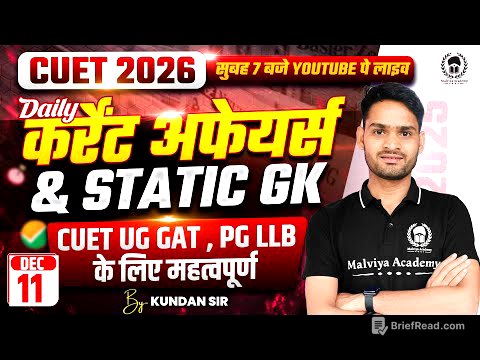TLDR;
This video provides a comprehensive guide to efficient learning, breaking down the process into four key parts: priming, absorbing, retrieving, and spacing information. It emphasises active learning techniques, such as creating mental models, pre-testing, layering information, and using recall questions, to improve understanding and long-term retention. The guide also addresses the importance of spaced repetition and maintaining a balance between active and relaxed study methods for consistency and motivation.
- Priming the information involves creating a mental model and pre-testing.
- Absorbing the information involves layering and creating recall questions.
- Retrieving the information through active recall and spaced repetition.
- Spacing the information to enhance long-term retention.
Intro [0:00]
Zain Asif, a third-year medical student, introduces a comprehensive guide to efficient learning. He highlights that many students struggle with studying because they aren't taught how to learn effectively. The guide aims to provide a practical, step-by-step method to learn, understand, and excel in exams. It's an active guide that encourages real-time engagement through recall exercises and practical actions. The guide is divided into four parts: priming, absorbing, retrieving, and spacing information.
Practical Action [1:25]
The presenter prompts viewers to write down the four steps of efficient learning—priming, absorbing, retrieving, and spacing—and to consider their current understanding and application of these concepts in their study routine. This exercise encourages viewers to actively engage with their own learning processes and think about potential improvements.
PART 1 - PRIMING THE INFORMATION [1:52]
Priming the information involves scoping out a new topic, looking at subtopics, and skimming through it. The key is to create a broad mental model of the topic to provide an underlying way to think about each point. This approach contrasts with the inefficient method of reading information multiple times without a clear structure, which results in poorly connected and easily forgotten points.
Step 1- Create the Mental Model [3:11]
The first step in priming information is to build a mental model of the topic. This involves creating a base for future learning, akin to a skeletal structure of the chapter, before diving into the details. The presenter will explain how to do this in a three-step practical method.
Step 1.1 Practical Method for Priming [3:44]
When learning something new, the initial step involves scanning the chapter and skimming through the different topics, bolded words, and key sentences. Alongside this, create a list of 15 to 20 prominent keywords noticed in the chapter. The key is to ensure the words are unordered, preventing bias towards the author's structure.
Step 1.2 [5:07]
After creating the unordered list of keywords, the next step is to look up any terms that are unfamiliar. Spend no more than 30 seconds on each word, focusing on understanding their meaning and potential relation to other concepts on the list. Limit this activity to under 10 minutes to avoid getting bogged down in specific details.
Step 1.3 [5:37]
Use existing knowledge to consider how the different words, ideas, and concepts within the chapter link together. Create a mind map that links all the concepts of the chapter, grouping them based on similarities or differences. This requires active, effortful thinking to organise and connect the concepts effectively.
Implications of this Method [7:04]
When reading the chapter later, each subtopic and bullet point will be considered in relation to the initial mental model. This process helps to determine if the new information aligns with initial thoughts and makes sense within the established framework. Creating relevance in this way is crucial for effective learning, as it deepens understanding by relating new information to something already known.
Step 2- Initial Questions (Pre-testing) [8:27]
Testing is more effective for long-term retention than rereading or passive note-taking. Students who test themselves before learning a topic perform better than those who study for twice as long. Even getting 90-95% of pre-test questions wrong can lead to better exam performance.
Practical Action [9:19]
Before starting to learn, begin by testing yourself with practice questions. Aim to answer around 15 to 20 multiple-choice questions (MCQs) to assess existing knowledge and identify weak areas. This helps focus on specific topics that require more attention.
Practical Action [10:17]
The presenter asks viewers to pause and summarise the first two steps of priming themselves before starting a topic, reinforcing active recall.
Step 3- Pre-reading [10:30]
Pre-reading involves skimming the chapter, creating an initial mental model, and watching a brief video to grasp basic concepts. Dedicate time to pre-read difficult chapters or assign a day to pre-read upcoming information. This practice fills the gaps in understanding, ensuring that new knowledge doesn't fall through.
PART 2- ABSORBING THE INFORMATION [11:58]
To effectively absorb information, give it meaning and relevance. Creating an initial mental model allows new information to automatically become relevant, leading to frequent "aha" moments. When reading new information, consider how it links to the initial mental model.
Step 1- Layering + Practical Method [13:48]
Read and absorb information in layers, from easiest to hardest. Start by skimming the chapter and making general sense of the topics. Then, go through general concepts, avoiding detailed memorisation. Finally, tackle the detailed and difficult concepts. This approach leverages prior knowledge to make memorisation easier and more efficient.
Step 2- Create Recall Questions [15:55]
Convert important explanations, processes, and details into a list of questions to test yourself later. If past papers and question banks are available, use these questions as a supplement. If not, create questions instead of making notes.
Practical Tips to Create Good Qs [16:34]
While studying, create specific questions using words like "define," "name," "analyse," and "describe." Aim for about 20 questions per subtopic. Continuously making these questions keeps you engaged and less likely to get bored.
Step 3- Teaching Everything [17:48]
Teaching a topic is the ultimate test of understanding. Explain your mental model, main concepts, and details to yourself or others. This reveals areas of confusion and solidifies your understanding.
Practical Action [18:28]
After reading a chapter, spend 15 to 20 minutes summarising and teaching yourself the main concepts. Use analogies, mnemonics, and layman's terms to describe the information. This helps reconstruct the concept and make it more memorable.
PART 3- RETRIEVING THE INFORMATION [19:14]
Testing yourself is more effective than rereading or passive note-taking. Retrieval of information from your brain makes knowledge stick longer. Testing should be repeated in spaced intervals.
Practical Action [20:47]
Incorporate retrieval practice within study sessions. Continuously ask yourself key questions, identify new terms, and relate information to existing knowledge. Cover the page and recall what you've just read.
Practical Action [21:41]
The presenter prompts viewers to recall what they've learned so far about priming and absorbing information, reinforcing active testing.
Recall Question Method [22:06]
Start each revision session by answering the list of questions you made without using any resources. Spend time trying to remember the information, as the effort strengthens neural connections. After attempting the questions, review the content to fill in knowledge gaps.
Tips for the Method. Why not flashcards? [23:32]
Avoid writing out answers to the recall questions. Instead, go back to the original source to find the answers. This makes revision more effective because you understand how the answer fits in context with other information.
Interleaving for STEM Subjects [24:35]
For subjects like chemistry, physics, and maths, interleave the studying of different problem types. Avoid Mindless repetition of the same method. Instead, identify the method needed to solve a problem and then apply it.
Practical Action [25:20]
Create a list of recall questions that includes only one or two problems for each problem type. Use this list to test yourself, encountering different types of questions constantly. If you don't know how to solve a problem, go back to the textbook and practice similar questions.
PART 4- SPACING THE INFORMATION [26:03]
Spaced practice involves repeating and actively revising a topic in spaced intervals, with increasing durations between repetitions. This helps you remember more information because the harder your brain has to work to retrieve it, the better you'll remember it.
The Problem with Spaced Repetition [27:13]
The main issue with spaced repetition is that scheduling it for all topics can be near impossible. The solution is to reduce the amount of repetitions per topic and make each repetition session extremely effective.
Practical Action- My Spaced Repetition System [27:53]
Start revision four to five weeks before an exam. For challenging topics, aim for at least three repetitions: one on day one, another on day three or four, and a final one at least two weeks later. For less challenging topics, do only one or two repetitions.
The Reality of "Efficient" Studying + Active Recall [28:47]
Efficient studying and testing can significantly improve exam performance. However, it's important to balance active studying with more relaxed methods like light reading or watching videos. Aim for a 70/30 balance between active and relaxed studying to stay consistent and motivated.
Final bits [30:17]
The video concludes by summarising the guide's key points, from initially approaching information to mastering it through recall and practice. The presenter encourages viewers to use the methods to improve their studying and achieve success in exams.









